

Illustrating the Big Picture. Experience designers use a wide variety of techniques to represent the interactions between individuals, organizations, and systems.

Personas are the go-to tool to aggregate a target audience’s traits, intentions, needs, and behaviors; however, they often leave out one of the most critical elements of interaction design: time. As rich as these snapshots may be, people’s needs and even their traits may change over time, and personas start to burst at the seams when it comes to illustrating a full story of engagement.
To show personas moving through time, we traditionally use task flows, scenarios, and storyboards. Often these models focus on limited experiences or specific interactions between user and system during a fairly short period of time. Naturally, UX professionals are adapting traditional techniques and creating new ones to express this greater scope of experience.
What is Journey Modeling? Journey model of the ‘player’ of a health behavior change game. Creating a Journey Model. Agile UX: User Experience Design in the world of Agile Software Dev... Agile UX vs Lean UX – How they’re different and why it matters for UX designers. I’ve seen a lot of discussion recently on what the difference is between Agile UX and Lean UX.
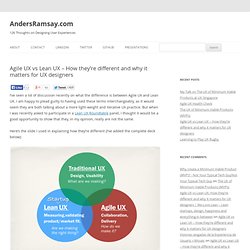
I am happy to plead guilty to having used these terms interchangeably, as it would seem they are both talking about a more light-weight and iterative UX practice. But when I was recently asked to participate in a Lean UX Roundtable panel, I thought it would be a good opportunity to show that they, in my opinion, really are not the same. Here’s the slide I used in explaining how they’re different (I’ve added the complete deck below):
Courses. More Than Usability: The Four Elements of User Experience, Part I. By Frank Guo Published: April 24, 2012 “UX professionals use the term user experience much more broadly, to cover everything ranging from ease of use to user engagement to visual appeal.
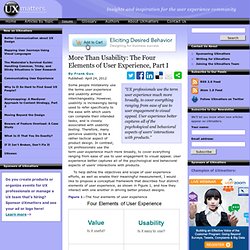
User experience better captures all of the psychological and behavioral aspects of users’ interactions with products.” Some people mistakenly use the terms user experience and usability almost interchangeably. However, usability is increasingly being used to refer specifically to the ease with which users can complete their intended tasks, and is closely associated with usability testing. More Than Usability: The Four Elements of User Experience, Part III. By Frank Guo Published: March 4, 2013 “Understanding the relative importance of the four elements is critical to correctly prioritizing product design and development efforts.”
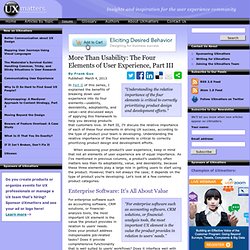
In Part II of this series, I explained the benefits of breaking down user experience into its four elements—usability, desirability, adoptability, and value—and discussed ways of applying this framework to help you develop products that customers love. In Part III, I’ll discuss the relative importance of each of these four elements in driving UX success, according to the type of product your team is developing. Understanding the relative importance of the four elements is critical to correctly prioritizing product design and development efforts. More Than Usability: The Four Elements of User Experience, Part II. By Frank Guo.
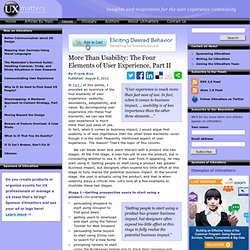
Itws2110.davidwatson.name/sites/default/files/lec11_front-end.pdf. 52 Weeks of UX. Pluralistic walkthrough. The Pluralistic Walkthrough (also called a Participatory Design Review, User-Centered Walkthrough, Storyboarding, Table-Topping, or Group Walkthrough) is a usability inspection method used to identify usability issues in a piece of software or website in an effort to create a maximally usable human-computer interface.
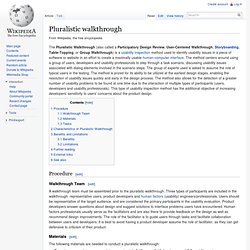
The method centers around using a group of users, developers and usability professionals to step through a task scenario, discussing usability issues associated with dialog elements involved in the scenario steps. The group of experts used is asked to assume the role of typical users in the testing. The method is prized for its ability to be utilized at the earliest design stages, enabling the resolution of usability issues quickly and early in the design process. Procedure[edit] Walkthrough Team[edit] A walkthrough team must be assembled prior to the pluralistic walkthrough. Materials[edit] The following materials are needed to conduct a pluralistic walkthrough: Tasks[edit] Frontend first. Some time ago, I blogged about the different phases of mental transition when working with JavaScript frontends.

Here's the shorten version:1. No-JavaScript phase 2. JQuery explosion 3. 4. Once you're in phase 4 and you create apps this way, you realize that you don't need the backend in order to create the Single Page App. Frontend first This is the additional phase. We've tried this approach in several Single Page Apps and it worked great for us. To learn more about Single Page Applications. Continuous Customer Feedback Programs, Part 1: Getting Started.
By Marnie Andrews and April L. de Vries Published: June 17, 2013 “Take the classic focus group and turn it into a continuous customer feedback program—a program of recurring sessions that feed your product team the qualitative research it needs.”

In this first part of our series of articles about customer feedback programs, we’ll describe how to take the classic focus group and turn it into a continuous customer feedback program—a program of recurring sessions that feed your product team the qualitative research it needs. We’ll draw from our own experience running such programs at IBM. The goal of a continuous customer feedback program is to engage real users in conversations about your product.
Identify and verify customers’ goals, behaviors, and attitudes. You can use the findings from these conversations to support the design recommendations that you provide to your product development team. Why Create a Continuous Customer Feedback Program? Setting Up Your Customer Feedback Program. Demystifying UX Design: Common False Beliefs and Their Remedies: Part 3. Demystifying UX Design: Common False Beliefs and Remedies: Part 2. By Frank Guo Published: December 10, 2012 “Many hold a firm belief that high information density is something to avoid at all costs.”

In Part 1 of my series Demystifying UX Design, I wrote about two design issues that people commonly and falsely believe to be problematic: long pages and the number of clicks it takes for users to get to information. In Part 2, I’ll discuss another common false belief relating to high information density and provide design recommendations for addressing this issue. Through my interactions with UX designers and Web product managers, I’ve found that many hold a firm belief that high information density is something to avoid at all costs.
“If a page is well designed, high information density does not compromise either the reading experience or usability.” However, if a page is well designed, high information density does not compromise either the reading experience or usability. Taking a closer look, it’s easy to see that the page is very well organized. Demystifying UX Design: Common False Beliefs and Their Remedies: Part 1. By Frank Guo Published: October 8, 2012 “There are many common beliefs about UX design that are, unfortunately, based on casual and inaccurate observation.”
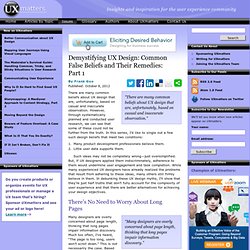
There are many common beliefs about UX design that are, unfortunately, based on casual and inaccurate observation. However, through systematically planned and conducted user research, we can see that some of these could not be further from the truth. Service Design + Lean UX + Disruptive Design = UX Strategy? By Mona Patel Published: May 20, 2013 “A UX strategy needs to be alive and current to be valuable.” If you were moving to New York City, what would get you excited? You might say the nightlife or the food. But for the geek in me, it was getting Verizon FiOS (Fiber Optic Service). Since I had gotten nowhere trying to order FiOS by phone, I next tried ordering FiOS online. The point is that it was one of the most frustrating customer experiences that I’ve had to date. First Steps in Your User Experience Workflow: Nascent UX.